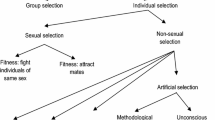Abstract
Susan Mills and John Beatty proposed a propensity interpretation of fitness (1979) to show that Darwinian explanations are not circular, but they did not address the critics' chief complaint that the principle of the survival of the fittest is either tautological or untestable. I show that the propensity interpretation cannot rescue the principle from the critics' charges. The critics, however, incorrectly assume that there is nothing more to Darwin's theory than the survival of the fittest. While Darwinians all scoff at this assumption, they do not agree about what role, if any, this principle plays in Darwin's theory of natural selection. I argue that the principle has no place in Darwin's theory. His theory does include the idea that some organisms are fitter than others. But greater reproductive success is simply inferred from higher fitness. There is no reason to embody this inference in the form of a special principle of the survival of the fittest.
Similar content being viewed by others
References
Beatty, J.: 1980, ‘What's Wrong with the Received View of Evolutionary Theory?’, PSA 1980 2, 397–426.
Beatty, J.: 1984, ‘Chance and natural Selection’, Philosophy of Science 51, 183–211.
Brandon, R. N.: 1978a, ‘Evolution’, Philosophy of Science 45, 96–109.
Brandon, R. N.: 1978b, ‘Adaptation and Evolutionary Theory’, Studies in History and Philosophy of Science 9, 181–206.
Brandon, R. N.: 1980, ‘A Structural Description of Evolutionary Theory’, PSA 1980 2, 427–39.
Brandon, R. and J. Beatty: 1984, ‘Discussion: The Propensity Interpretation of “Fitness” — No Interpretation Is No Substitute,’ Philosophy of Science 51, 342–347.
Burian, R.: 1983, ‘Adaptaton, ’ in M. Grene (ed.), Dimensions of Darwinism: Themes and Counterthemes in Twentieth Century Evolution Theories, Cambridge University Press, Cambridge.
Darwin, C.: 1859, On the Origin of Species, fasimille of the first edition, 1964, Harvard University Press, Cambridge, Mass.
de Beer, G.: 1971, ‘Charles Robert Darwin’, in Dictionary of Scientific Biography, Vol. III, pp. 565–567.
Giere, R. N.: 1973, ‘Objective Single Case Probabilities and the Foundations of Statistics’, in Suppes et al. (eds.), Logic, Methodology, and the Philosophy of Science IV, North-Holland, Amsterdam, pp. 467–83.
Giere, R. N.: 1976, ‘A Laplacean Formal Semantics for Single Case Propensities’, Journal of Philosophical Logic 5, 321–53.
Jenkin, F.: 1867 ‘The Origin of Species’, The North British Review 46, 277–318. Excerpts printed in David Hull, Darwin, And His Critics, Harvard University Press, Cambridge, Mass., pp. 302–50.
Lewontin, R. C.: 1970, ‘The Units of Selection’, Annual Review of Ecology and Systematics 1, 1–18.
Lloyd, E. A.: 1984, ‘A Semantic Approach to the Structure of Population Genetics,’ Philosophy of Science 51 242–64.
Manser, A. R.: 1956, ‘The Concept of Evolution,’ Philosophy 40, 18–34.
Merachnat, J.: 1916, Alfred RussellWallace; Letters and Reminiscences, Harper and Brothers, New York and London
Mills, S. K. and J. H. Beatty: 1979, ‘The Propensity Interpretation of Fitness’, Philosophy of Science 46, 263–286.
Popper, K.: 1974, ‘Intelectual Autobiography’, in Schilpp (ed.), The Philosophy of Karl Popper, Open Court, LaSalle, Ill.
Rosenberg, A.: 1982, ‘Discussion: On the Propensity Definition of Fitness’, Philosophy of Science 49, 268–73.
Ruse, M.: 1971, ‘Natural Selection in The Origin of Species’, Studies in History and Philosophy of Science 1, 311–51.
Smart, J. J. C.: 1963, Philosophy and Scientific Realism, Routledge and Kegan Paul, London.
Sober, E.: 1981, ‘Evolutionary Theory and Ontological Status of Properties’, Philosophical Studies 40, 147–76.
Suppes, P.: 1967, ‘What Is a Scientific Theory?’ in S. Morganbesser (ed.), Philosophy of Science Today, Van Nostrand, New York.
Thompson, P.: 1983, ‘The Structure of Evolutionary Theory: A Semantic Approach’, Studies in the History and Philosophy of Science 14, 215–29.
van Fraasen, B.: 1980, The Scientific Image, Clarendon Press — Oxford University Press, Oxford.
Williams, M. B.: 1970, ‘Deducing the Consequences of Evolution: A Mathematical Model.’ Journal of Theoretical Biology 29, 343–85.
Author information
Authors and Affiliations
Additional information
I would like to thank John Beatty, Ron Giere, Philip Kitcher and John Winnie for detailed and helpful criticisms of an earlier draft of this paper.
Rights and permissions
About this article
Cite this article
Waters, C.K. Natural selection without survival of the fittest. Biol Philos 1, 207–225 (1986). https://doi.org/10.1007/BF00142902
Issue Date:
DOI: https://doi.org/10.1007/BF00142902



